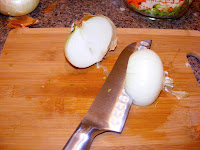 |
| On the plate, l-r, Chocolate Chip, Peanut Butter, and Oatmeal Raisin cookies. |
There are a lot of cookies in the world, but when comfort is what you’re looking for, there are a few, basic, tried-and-true crowd favorites... also quick and easy-peasy, to have in your repertoire.
These three cookies -- chocolate chip (of course!), peanut butter, and oatmeal raisin -- are cookie staples. Not only are they family favorites good for anytime you carve warm, delicious, melt-in-your-mouth goodness served with a glass of icy cold milk, but they are go-to recipes when you need to whip up a quick batch of something sweet to take to any social gathering and they use ingredients I always have on hand ... no special trips to the grocery store.
I’m thinking about comfort in particular today, because I need to take something to a funeral reception where sweets in particular is what has been requested. A lot of times when I am taking food to a pot luck or other function, I tend not to choose the overly familiar dishes. But when I started thinking about what to make for a time of grief and sadness, I wanted to choose something that conveys home, comfort and familiarity exactly.
I have lots of travel ware and lovely serving pieces that I often use for potlucks, parties, etc. But for a funeral reception at a friend’s home, I decided to pack these cookies, once cooled, in large plastic bags. It’s not a time I want someone who’s grieving to worry about getting serving ware back to the right person. I’ll take along a disposable aluminum tray to serve them on. No fuss. No muss.
For this occasion, I made a batch of each type, which was easy to do in a single morning.
TIPS for SUCCESS
- Get all ingredients and equipment necessary out on the counter within easy reach. No need to haul out the Kitchen Aid mixer -- a hand mixer is perfect.
- I make each dough in succession, popping each one as it is completed into the fridge to firm up a bit before baking. I like cookies that are slightly crispy on the outside, chewy and melty-good on the inside, and that have a nice rise instead of spreading out on the pan. Refrigerating dough helps avoid spread.
- Use light colored cookie pans instead of dark. Dark colored pans tend to over-brown the bottoms of cookies.
- I have 3 really large solid quality cookie pans I rotate when making big batches of cookies. I line each one wit foil or parchment for baking (foil will also help keep bottoms from over-browning if a dark pan is all you have) and after taking each batch out of the oven the sheet of cookies slides easily off the pan to cool, cookies never stick, and then the pan cools pretty quickly to go back into rotation. And no clean up. Using this method I can keep cookies going into the oven steadily.
- If you make a lot of cookies, it’s worth investing in a cookie scoop. Keeps the size uniform for even baking; gets the job done faster.
One last word about these recipes: I have made a ton of cookies in my life. I own a wall of cookbooks ranging from Le Cordon Bleu to an old Betty Crocker picture cookbook from my mother’s days as a young housewife, and everything in between. But in my opinion, the very best comfort chocolate chip, oatmeal raisin, and peanut butter cookie recipes I have ever made come off the cardboard Butter Flavor Crisco Sticks label/wrapper. No shit. They are the best. Ever. Of all the recipes I’ve tried over the years.
And they are easily found online, so I’m going to save myself some time and just post the links.
Ultimate Chocolate Chip Cookies (My kids and I prefer chocolate chip cookies without the nuts. Leave them out and throw in another 1/2 cup or more chocolate chips if you like chocolate like I do. Semi-sweet chocolate is a must. Mini-chips also acceptable. Keep your white chocolate. Not a fan.)
Ultimate Chewy Oatmeal Raisin Cookies (I put 1/2 cup chopped walnuts in half the dough and keep the other half plain.)
Ultimate Peanut Butter Cookies (You can do these as simple drop cookies if you want, but I use the cookie scoop - of course - and quickly roll each scoop into a ball and roll it in sugar then use fork tines to slightly flatted the dough ball making the traditional criss-cross pattern on the peanut butter cookie.)














